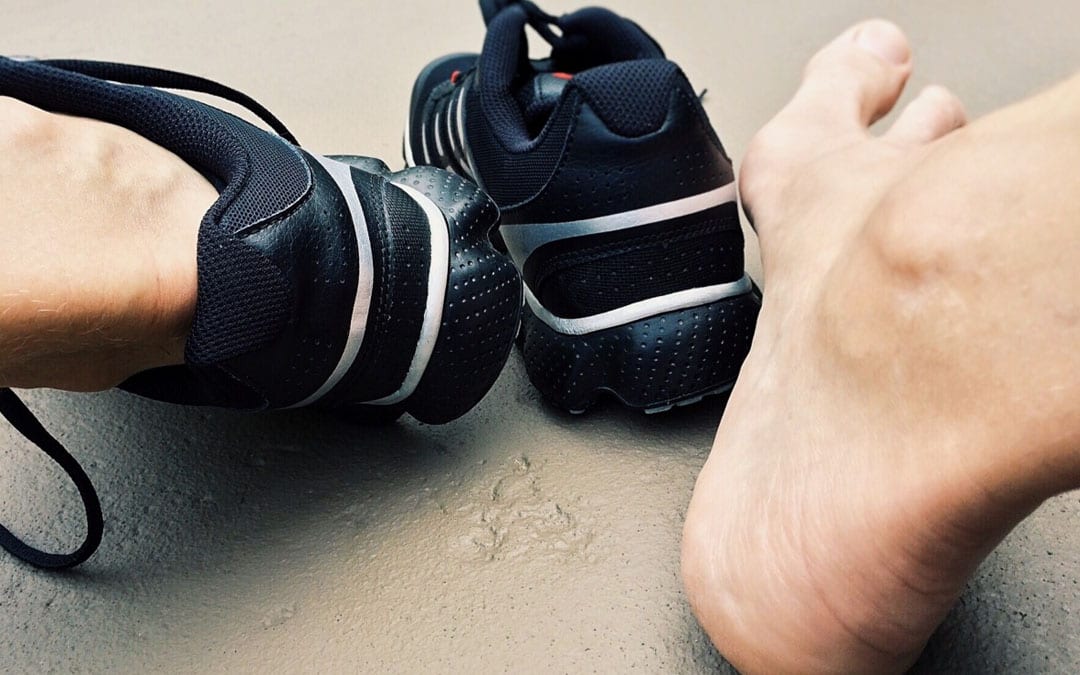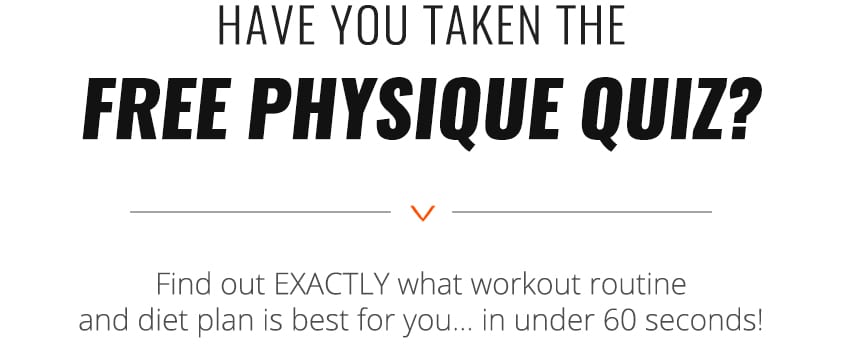Your shoes have a HUGE impact on your workouts.
They are literally the only thing standing between your body and the gym floor.
The right shoes will improve your force production, strength, stability, and comfort. The wrong shoes will limit your progress and put you at risk of injury.
NOTE: The basic Nike running shoes that 90% of guys wear to the gym these days simply won’t cut it. The soft cushion in their soles is made for running NOT lifting. This greatly reduces the amount of force you can generate through your feet.
Also, they’re made for running in straight lines, so they lack lateral support. This increases the chance that you lose your footing and roll an ankle, or drop a weight on yourself even.
It’s time to ditch the running shoes and go with one of these 3 superior options…
Option #1: Minimalist Shoes for Lifting
Minimalist shoes have become super popular over the last few years.
Their purpose is to offer you the benefits of barefoot training, while still maintaining some degree of protection and shock absorption.
Benefits: Their main benefit is that bypass the problem you see with most other gym shoes (running, tennis, and cross trainers). They have a minimalist sole that allows you to transfer a higher degree of force through your feet, and into the ground. This is because they don’t have a thick, soft sole to absorb this force and limit your force output (like a running shoe does).
A study measuring power during a vertical jump proves this fact, showing a greater peak power in minimalist shoes (vs. tennis shoes).
Another benefit, and the main reason I use these for most workouts, is that they offer an all-in-one solution. No more taking off your shoes when you squat and deadlift. No more bringing a pair of weightlifting shoes AND a pair of running shoes to the gym. Nope, just show up and you’re good to go.
Drawbacks: If you have poor hip mobility and difficulty squatting to proper depth, you’re better off going with weightlifting shoes (see option #2 below). This is because the heel is not raised on minimalist training shoes.
Also, because they don’t have a thick sole that cushions your impact, they’re less comfortable than a regular shoe if you wear them for long periods of time (3+ hours).
Recommendation: New Balance Minimus Training Shoe – this shoe has the industry standard Vibram sole, but not the goofy 5-finger look. I use a pair of these as my main lifting shoe.
Option #2: Weightlifting Shoes
The popularity of weightlifting shoes has also been growing. In fact, you’ve probably seen a few pairs around the squat racks in your gym.
These are also called olympic weightlifting shoes, and they’re made specifically for squats, deadlifts, and the olympic lifts (cleans, snatches, etc).
Benefits: There are 2 main benefits of using weightlifting shoes. First, they have a solid sole that allows you to transfer force through your feet more efficiently (the same as I explained for minimalist shoes in option #1).
Second, the heel is raised significantly. This is a HUGE benefit for people who have trouble getting into a deep squat. You see, the main reason guys have trouble getting into a deep squat is because of a lack of mobility in their ankle (more specifically: poor dorsiflexion, or not being able to flex your foot upwards very far towards your knee).
By raising your heel off of the ground, you essentially change your starting position and bypass this relative lack of mobility. Think about this way: if your heel always wants to come off the ground when you’re squatting, and then you give it a higher platform to rest on, it’s essentially raised and won’t need to go any higher.
Note: Stretching and foam rolling your calves (and doing mobility work) will also correct this issue. But weightlifting shoes are a quick fix.
Drawbacks: These are really only useful for squatting, deadlifting, and olympic lifts, so I know a lot of guys who bring another pair of shoes to the gym for the rest of their workout (usually a more comfortable and stylish pair).
Recommended Shoe: Adidas Powerlift Training Shoe – a bunch of my buddies use these and love them. I also think they look better than every other weightlifting shoe out there.
Option #3: Barefoot Training
The final option is barefoot training. This is still pretty uncommon, but there are some big advantages to it…
Benefits: Let’s be honest here, the whole point of minimalist shoes is to mimic barefoot training. So why not just train barefoot in the first place?
Barefoot training allows you to generate even more power than with minimalist shoes (as measured in the same study I covered in option #1). Also, many people prefer the feeling of “freedom” you get when training barefoot.
A common concern people have about barefoot training is that they’ll be screwed if they drop a weight on their foot. And it’s true. But unless you’re wearing steel-toe Timberland boots to the gym, you’re going to be screwed either way.
Drawbacks: Same as with minimalist shoes, they don’t give you the raised heel advantage of weightlifting shoes (for guys with poor hip mobility). Also, some gyms don’t allow you to train barefoot.
Recommendation: Pedestal Footwear Barefoot Training Socks – These are fucking dope! The bottom is abrasion resistant and has an amazing grip, so you won’t cut up your foot or slip while you’re lifting. Plus they’re silver-treated to prevent smell and bacteria growth.
Note: Use coupon code HOWTOBEAST for a 10% discount (full disclosure: my buddy Mike makes these, but I promise: I actually use these and love them).
So What Are the Best Shoes for Weightlifting?
If you have trouble squatting to proper depth, the answer is pretty clear: a solid pair of weightlifting shoes (like the Adidas I linked to above) will be best for you.
If you good hip mobility and don’t have issues with your squat or deadlift form, then it really comes down to preference. Minimalist shoes, weightlifting shoes, and barefoot training are all great options, and they all bypass the issues you run into with running or tennis shoes.
If your gym allows barefoot training, this is clearly the cheapest option. Just grab a pair of Pedestal socks (see option #3) or slip off your running shoes when you’re squatting or deadlifting and you’re good to go.




Other advantages of shoes over socks or bare feet, is they contain any sweat, keeping your floor cleaner and more sanitary; Hitting your toes with a missed jump rope is not nearly as painful in shoes as without; Shoes grip the floor better than most socks, and offer protection from scuffs, stubs, heat, and foreign objects when training on cement or asphalt.
Good point Geordon, shoes definitely protect the bottom of your feet, although those Pedestal socks also do a good job (not as much protection as a shoe sole of course).
I personally have been using converse after reading about the lifters at Westside using them. So far they’ve been great especially for the main lifts such as squat, deadlift, bench press, etc. Might have to try out those socks look convenient Was surprised how big of a difference footwear has on a workout.
Good point Charles – converse chuck taylors are great too. Comfortable and a rock solid sole that’s also nice and wide.
I’ve been thinking about getting Adipowers for a long time… I’m just not that strong so I feel like I would look silly wearing weight lifting shoes. I could definitely use the help they provide with my squat though!
Yeah if you struggle to get good depth then I definitely recommend them.
I just ordered a couple pairs of Skinners. They look like socks but have a tough but thin bottom. Just curious if anyone has used these in the gym yet. They’re from a kickstarter.
No I have not. Only the Pedestal socks I linked in the article.
A notable study highlighting the increase in maximal power during activities such as vertical jumping highlights the effectiveness of minimalist footwear in optimizing force output. Beyond efficiency, their practicality shines as an all-in-one solution for a variety of exercises, eliminating the need to switch between different types of shoes. I also wrote this in my annotated bibliography format here https://paperwriter.com/blog/annotated-bibliography-in-apa-format
I usually don’t play games, but heardle Game Unlimited has changed my mind. The game is simple to understand, and I can test my memory with songs I’ve heard before. It’s a wonderful way to relive musical memories from the past.